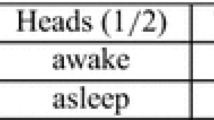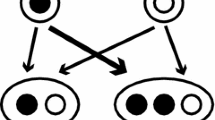Abstract
Ever since Elga presented his famous puzzle of Sleeping Beauty, philosophers have debated between the Thirder and the Halfer positions. In his recent article, Daniel Singer proposes a new position, according to which Beauty ought to assign [0, 1/2] to (H) the coin’s landing heads. For this argument, he exploits the similarity between Elga’s original puzzle and Bovens’s modified one. According to Singer, Beauty ought to assign the same credence to H (at the relevant moments) in both versions of Sleeping Beauty. Since Beauty ought to assign [0, 1/2] to H in Bovens’s version, she ought to assign [0, 1/2] to H in Elga’s original version, too. Let us call this “the Impreciser view.” In this paper, I will contend that Singer’s argument fails. First, he depends on false assumptions in defending his Impreciser view. Second, Bovens’s version of Sleeping Beauty turns out to be underdescribed in an important aspect. If we try to provide a fuller description for it, either Beauty does not have to assign [0, 1/2] to H or the thus complemented version of Bovens’s puzzle will fail to be analogous with Elga’s original one. In either case, Singer’s discussion does not establish his Impreciser view.
Similar content being viewed by others
Notes
For the standard explanation of why we need centered propositions as the objects of belief, see Lewis (1979). The Sleeping Beauty puzzle, to which we will apply the imprecise probabilism, is a well-known case in which the agent assigns credences to centered propositions.
Proof Let \(c\left( \cdot \right) \) be the agent’s prior credence function. Let \(\Pi \) be a partition \(\left\{ X_{i}\right\} _{i\in I}\). Suppose that the given agent receives evidence E such that \(c\left( E\equiv \vee _{j\in J}X_{j}\right) \) for some \(J\subseteq I\) and show that the result of applying SC to \(\Pi \) is the same as that of applying MVD to \(\Pi \). Define \(\Pi _{E}=\left\{ X_{j}\right\} _{j\in J}\). First, consider any \(i\in I-J\). By definition, \(X_{i}\in \Pi -\Pi _{E}.\) Hence, \(X_{i}\ne X_{j}\) for any \(j\in J\). Since \(\Pi \) is a partition, \(X_{i}\) is incompatible with \(X_{j}\) for any \(j\in J\). So \(X_{i}\) is incompatible with \(\vee _{j\in J}X_{j}\). By supposition, \(c\left( X_{i}/E\right) =c\left( X_{i}/\vee _{j\in J}X_{j}\right) =0\). Next, consider any \(k,l\in J\). So \(X_{k}\) entails \(\vee _{j\in J}X_{j}\). Thus, \(X_{k}\) is equivalent to \( X_{k} \& \vee _{j\in J}X_{j}\). By similar reasoning, \(X_{l}\) is also equivalent to \( X_{l} \& \vee _{j\in J}X_{j}\). By supposition, \( c\left( X_{k}/E\right) :c\left( X_{l}/E\right) =c\left( X_{k}/\vee _{j\in J}X_{j}\right) :c\left( X_{l}/\vee _{j\in J}X_{j}\right) =c\left( X_{k} \& \vee _{j\in J}X_{j}\right) :c\left( X_{l} \& \vee _{j\in J}X_{j}\right) =c\left( X_{k}\right) :c\left( X_{l}\right) \). Finally, by supposition, \( \sum _{j\in J}c\left( X_{j}/E\right) =\sum _{j\in J}\frac{c\left( X_{j} \& E\right) }{c\left( E\right) }=\sum _{j\in J}\frac{c\left( X_{j} \& \vee _{j\in J}X_{j}\right) }{c\left( \vee _{j\in J}X_{j}\right) }=\frac{c\left( \vee _{j\in J}X_{j}\right) }{c\left( \vee _{j\in J}X_{j}\right) }=1.\) In sum, the agent assigns zero to any \(X_{j}\in -\Pi _{E}\), the ratio between her credences in the members of \(\Pi _{E}\) remain the same, and the new credences in \(\Pi \)’s members sum to one. Done.
In fact, Singer assumes that (A3*) \( WAKE1\equiv \left[ \left( H \& Mo\right) \vee \left( T \& Mo\right) \vee \left( T \& Tu\right) \right] \), not that Beauty is sure of (A3*). However, he seems to think that, just assuming (A3*), one is allowed to replace WAKE1 with \( \left[ \left( H \& Mo\right) \vee \left( T \& Mo\right) \vee \left( T \& Tu\right) \right] \) and vice versa. Not so. Such replacement is allowed only when one is sure of (A3*). In this paper, I will proceed with (A3) rather than (A3*).
Actually, this is a mistake. As we will see in Sect. 5, learning WAKE2 removes some centered proposition entailing T while not removing any centered propositions entailing H. Consequently, \(c\left( H\right)>\frac{1}{2}>c\left( T\right) \) for most of \(c\in \mathcal {R}_{2}^{\mathcal {B}}\). Of course, this contradicts (A1).
In the next section, we will see that (A1) is also false.
\(WAKE_{M}\) is a genuine proposition, whose truth value never changes or differs concerning any two worldmates. So it is different from (\(W_{M}\)) the centered proposition expressed by “Beauty is waking up now on Monday.” Similarly, \(WAKE_{T}\) differs from (\(W_{T})\) the centered proposition expressed by “Beauty is waking up now on Tuesday.” Importantly, while \(W_{M}\) and \(W_{T}\) are mutually incompatible, \(WAKE_{M}\) and \(WAKE_{T}\) can be both true.
To see why, consider any \(c\in \mathcal {R}_{m}^{\mathcal {B}}\). Clearly, when she is awakened is an independent matter from whether the coin lands heads or tails. So \( c(WAKE_{M} \& \lnot WAKE_{T}/H)=c(WAKE_{M} \& \lnot WAKE_{T}/T)\), \( c(\lnot WAKE_{M} \& WAKE_{T}/H)=c(\lnot WAKE_{M} \& WAKE_{T}/T)\), and \( c(WAKE_{M} \& WAKE_{T}/H)=c(WAKE_{M} \& WAKE_{T}/T)\). Since she knows that the coin is fair, \(c\left( H\right) =\frac{1}{2}=c\left( T\right) \). By definitions, \(c\left( H1\right) =c\left( T1\right) \), \(c\left( H2\right) =c\left( T2\right) \), and \(c\left( H3\right) =c\left( T3\right) \). Since each of H1 and T1 implies Mo, H1 is equivalent to \( H1 \& Mo\) and T1 is equivalent to \( T1 \& Mo\). Hence, \( c\left( H1 \& Mo\right) =c\left( H1\right) =c\left( T1\right) =c\left( T1 \& Mo\right) \). Similarly, \( c\left( H2 \& Tu\right) =c\left( T2 \& Tu\right) \) and \(c\left( H3\right) =c\left( T3\right) \). Finally, whether it is Monday or Tuesday is also independent from whether H3 or T3 holds. Thus, \(c\left( Mo/H3\right) =c\left( Mo/T3\right) \) and \(c\left( Tu/H3\right) =c\left( Tu/T3\right) \). Hence, \( c\left( H3 \& Mo\right) =c\left( T3 \& Mo\right) \) and \( c\left( H3 \& Tu\right) =c\left( T3 \& Tu\right) \).
Proof of (1) Suppose WAKE1. So either the coin does not land heads, in which case T holds, or she wakes up only once on Monday, in which case \( H1 \& Mo\) holds. In either case, it follows that \( T\vee \left( H1 \& Mo\right) \). On the other hand, if \(\lnot WAKE1\), then the coin lands heads and Beauty is awakened twice. It follows that \( \lnot T \& \lnot \left( H1 \& Mo\right) \). Proof of (2) Assume WAKE2. Hence, either the coin does not land tails, in which case H holds, or Beauty wakes up twice, in which case T3 holds and \(Mo\vee Tu\). In either case, \( H\vee \left( T3 \& Mo\right) \vee \left( T3 \& Tu\right) \). On the other hand, if \(\lnot WAKE2\), the coin lands tails but she does not wake up twice. In that case, \( \lnot H \& \lnot \left( T3 \& Mo\right) \& \lnot \left( T3 \& Tu\right) \). Done.
Proof Since \(\mathcal {R}_{m^{+}}^{\mathcal {B}}\left( H1\vee T3\right) =1\) and Beauty knows at \(m^{+}\) that H is equivalent to H1, \(c\left( H\right) =\frac{c\left( H1\right) }{c\left( H1\right) +c\left( T3\right) }\) for any \(c\in \mathcal {R}_{m^{+}}^{\mathcal {B}}\). Since updating by MVD should preserve the ratio between the credences in H1 and T3, \( \mathcal {R}_{m^{+}}^{\mathcal {B}}\left( H\right) =\left\{ \frac{c\left( H1\right) }{c\left( H1\right) +c\left( T3\right) }|c\in \mathcal {R}_{2}^{\mathcal {B}} \& c\left( WAKE1\right)>0\right\} =\left\{ \frac{c\left( H1\right) }{c\left( H1\right) +c\left( T3\right) }|c\in \mathcal {R}_{m}^{\mathcal {B}} \& c\left( WAKE1\right) >0<c\left( WAKE2\right) \right\} \) \(=\left\{ \frac{c\left( H1\right) }{c\left( H1\right) +c\left( T3\right) }|c\in S\right\} \), where \( S=_{df.}\left\{ c\left( \cdot \right) |c\in \mathcal {R}_{m}^{\mathcal {B}} \& c\left( WAKE\right) >0\right\} .\) For any \(c\in S\), \(c\left( H1\right) +c\left( T3\right) \ge c\left( WAKE\right) >0\) because Beauty knows at m that WAKE implies \(H1\vee T3\). For any \(c\in S\), if \(c\left( T3\right) >0\), \(\frac{c\left( H1\right) }{c\left( H1\right) +c\left( T3\right) }=f\left( \frac{c\left( H1\right) }{c\left( T3\right) }\right) \) and if \(c\left( H1\right) >0\), \(\frac{c\left( H1\right) }{c\left( H1\right) +c\left( T3\right) }=g\left( \frac{c\left( T3\right) }{c\left( H1\right) }\right) .\) Done.
For example, if \( H \& Mo\) fails to be realized, then either the coin lands heads and Beauty is awakened only on Tuesday or the coin lands tails and she is awakened on both Monday and Tuesday. Similarly for \( H \& Tu\), \( T \& Mo\), and \( T \& Tu\).
In fact, Bovens and Ferreira (2010) point out that there is an important structural difference between SBB2 and SBE. So protocol indeterminacy is not a serious problem in their discussion. Here, I ignore this fact deliberately because my present purpose is to explain the reviewer’s idea that the Sleeping Beatuy problem may become hard to solve due to protocol indeterminacy.
Due to the length limitation, I will not provide a detailed discussion of their proof here.
Proof Similar to footnote 10.
I feel grateful to an anonymous reviewer for referring me to Cisewski et al. (2016). Like me, they emphasize the difficulty of establishing the analogy between the original and tweaked versions of Sleeping Beauty. Seemingly, this is a general problem for any attempt to solve the Sleeping Beauty puzzle by the argument-by-analogy method.
References
Bovens, L. (2010). Judy Benjamin is a sleeping beauty. Analysis, 70, 23–6.
Bovens, L., & Ferreira, J. L. (2010). Monty Hall drives a wedge between Judy Benjamin and the Sleeping Beauty: A reply to Bovens. Analysis, 70(3), 473–81.
Cisewski, J., Kadane, J. B., Schervish, M. J., Seidenfeld, T., & Stern, R. (2016). Sleeping Beauty’s credences. Philosophy of Science, 83(3), 324–7.
Dorr, C. (2002). Sleeping Beauty: In defence of Elga. Analysis, 62, 292–6.
Elga, A. (2000). Self-locating belief and the Sleeping Beauty problem. Analysis, 60, 143–7.
Jeffrey, R. (1983). Bayesianism with a human face. In J. Earman (Ed.), Testing scientific theories, Minnesota studies in the philosophy of science (Vol. 10, pp. 133–156). Minneapolis: University of Minnesota Press.
Joyce, J. M. (2010). A defense of imprecise credences in inference and decision making. Philosophical Perspectives, 24, 281–323.
Lewis, D. K. (1979). Attitudes de dicto and de se. Philosophical Review, 88, 513–43.
Lewis, D. K. (1980). A subjectivist’s guide to objective chance. In R. C. Jeffrey (Ed.), Studies in Inductive logic and probability (Vol. II, pp. 263–293). Berkeley: University of California Press.
Lewis, D. K. (2001). Sleeping beauty: Reply to Elga. Analysis, 61, 171–6.
Singer, D. J. (2014). Sleeping beauty should be imprecise. Synthese, 191, 3159–72.
van Fraassen, B. C. (1989). Laws and symmetry. Oxford: Oxford University Press.
van Fraassen, B. C. (1990). Figures in a probability landscape. In M. Dunn & A. Gupta (Eds.), Truth or consequences (pp. 345–356). Dordrecht: Springer.
Author information
Authors and Affiliations
Corresponding author
Additional information
Publisher's Note
Springer Nature remains neutral with regard to jurisdictional claims in published maps and institutional affiliations.
This work was supported by the National Research Foundation of Korea (NRF) under the Grant funded by the Korean government (NRF-2015S1A5A2A03048814).
I would like to thank Daniel Singer, Ilho Park, Jaemin Jung and two anonymous reviewers for comments and discussions. In particular, I feel grateful to the reviewers for referring me to very useful papers.
Rights and permissions
About this article
Cite this article
Kim, N. Limitation of analogy in the Sleeping Beauty debate: the case of Singer’s argument. Synthese 198, 10513–10528 (2021). https://doi.org/10.1007/s11229-020-02733-w
Received:
Accepted:
Published:
Issue Date:
DOI: https://doi.org/10.1007/s11229-020-02733-w




